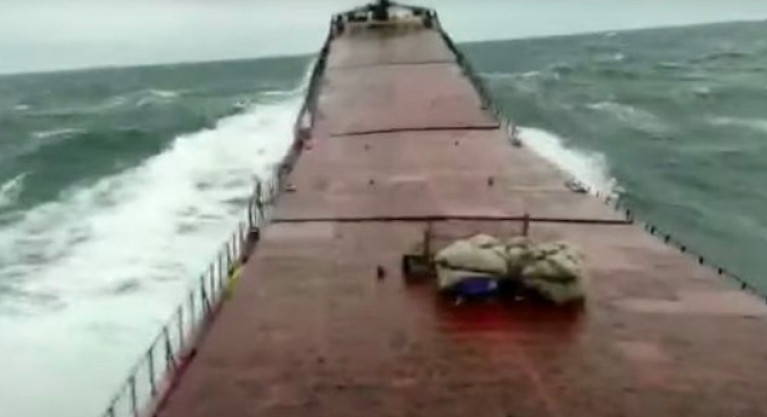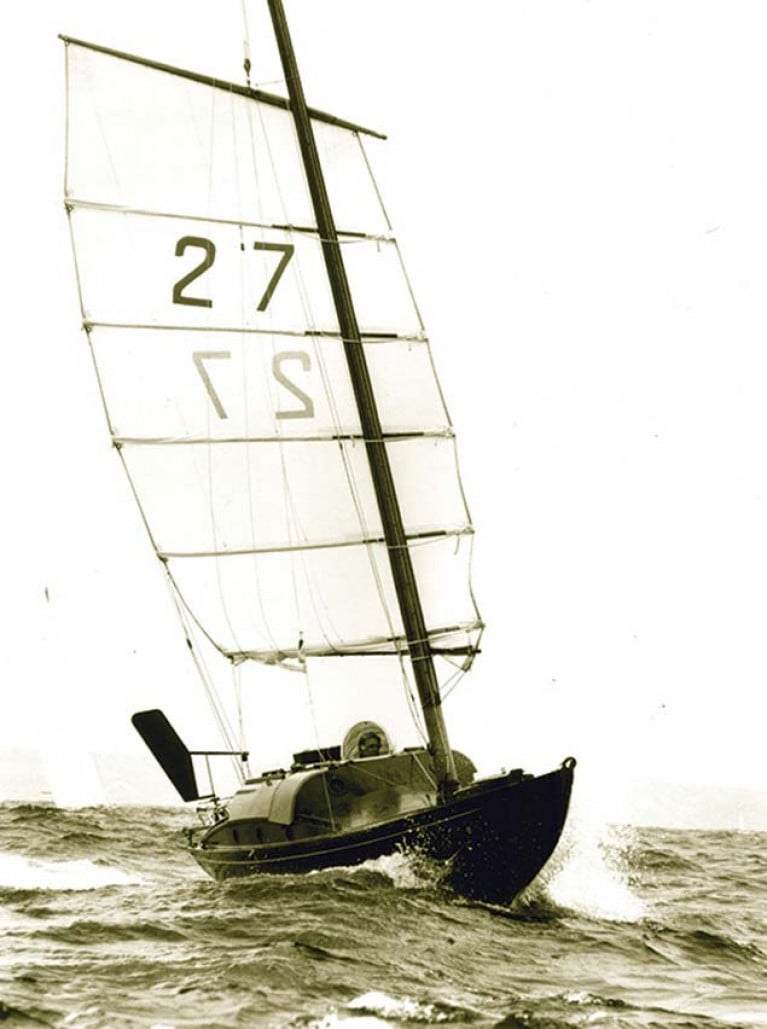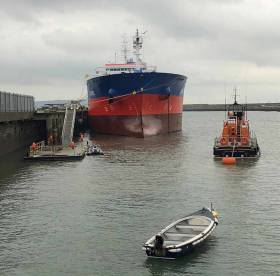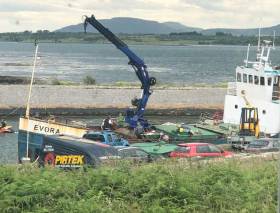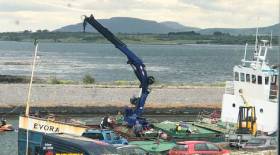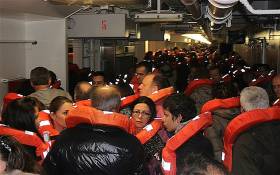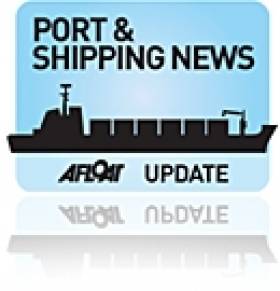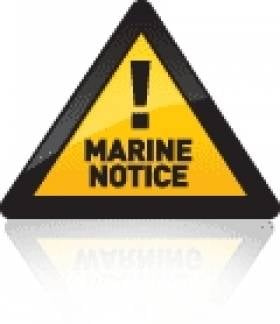Displaying items by tag: ship
Cargo Ship ‘Snaps in Half’ During Storm (Video)
A ship ‘snapped in half’ and sank off Turkey’s Black Sea coast while en route to Bulgaria.
Now, as Marine Industry News reports, a shocking video has been shared showing the crew making an emergency mayday call as the bow breaks.
Reports vary – some say that up to four crew members died in the incident. Rescue workers reportedly saved at least six people and retrieved the bodies of two others.
The Russian state agency overseeing sea and river fleets says the vessel belonged to the Ukrainian company Arvin Shipping Ltd.
According to Deha 24, Arvin is a river-sea cargo vessel type, vulnerable to strong storms at sea, because its structural strength isn’t sufficient enough to be fully seaworthy – it was too long and narrow. Arvin couldn’t stand against strong wind and waves and either broke in two, or was overwhelmed, while being anchored at Bartin anchorage in an attempt to shelter from a storm.
Can Ireland’s Wind Power Drive Modern Trading Ships?
The wind is free. No-one disputes that. But harnessing its power can be a very expensive business, particularly if you’re trying to do it at the top level of international competition writes WM Nixon. Yet at a more mundane level of sailing, with auxiliary sail power working in support of electric main engines, we should surely be able to develop cargo-carrying vessels which can work along the coast of Ireland and across the oceans with a minimal carbon footprint.
Their very existence would increase environmental awareness. And their regular functioning could possibly even include an element of Sail Training in their crewing. With this in mind, in a remote and very special place on the Connacht coast, some ideas and proposals of increasing importance have been developing.
Jamie Young of Killary Adventure Centre in far northwest Galway is one of Ireland’s most experienced seafarers, with his nautical skills allied to extensive aspects of mountain-craft to give him an unrivalled overview both of the realities of seafaring, and the techniques of training and leadership.
With the Adventure Centre’s Expedition Yacht being the alloy Frers 49 Killary Flyer (one of the best boats ever in Irish waters), his knowledge of the waters west of Greenland is unrivalled. And while many expect him to be among the first skippers in his category to circumnavigate Greenland, he says it may be some time yet before that happens, for although the passage on Greenland’s west and northwest coasts is slowly clearing north towards Cape Morris Jessup, the ice on Greenland’s far northeast coast continues to present an impassable challenge.
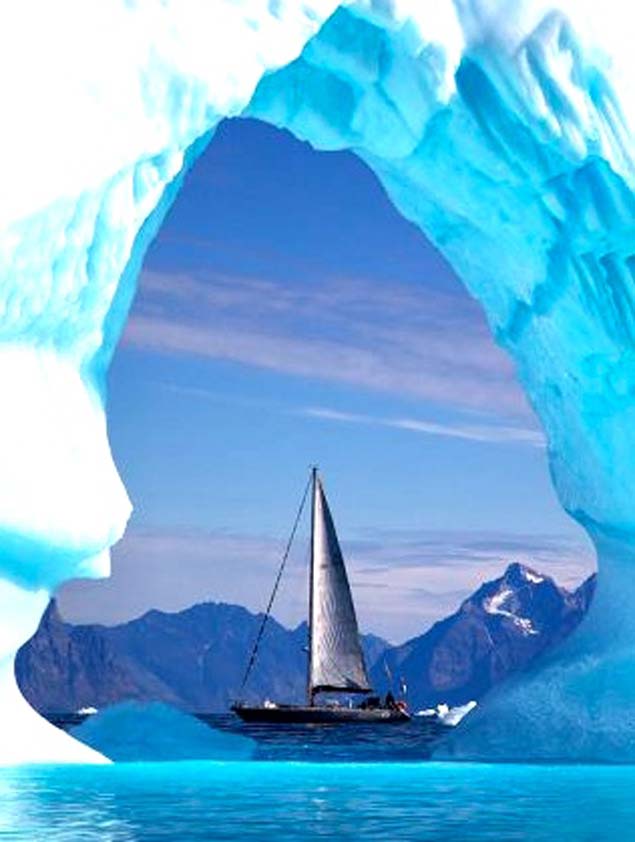 Killary Flyer among the ice of West Greenland. An alloy-built Frers 49, she has been a successful offshore racer (overall winner of the 1988 Round Ireland Race) and a very effective expedition yacht
Killary Flyer among the ice of West Greenland. An alloy-built Frers 49, she has been a successful offshore racer (overall winner of the 1988 Round Ireland Race) and a very effective expedition yacht
But the Greenland challenge and its deeper implications is only one of many items on the Jamie Young agenda. As he mentions in the following article, his extraordinarily varied and extensive CV includes a period when he and his wife Mary were the core professional crew on shipping magnate Huey Long’s Maxi Ondine.
Huey Long was notoriously parsimonious, so much so that we may do an article about it someday, for Don Street is another Irish-connected sailor who had to deal with it. Yet despite his penny-pinching approach, Long accepted that when the big boats from the small but very keen fleet of Maxis wandered the earth alone like dinosaurs in search of top-level glamorous competition, the most economical way to do the lengthy delivery trips was with minimal crew and entirely under engine.
Crews cost money, Maxis were organized to be sailed with large crews, and their sails were ultra-expensive. So the least expensive method of voyaging was to have a substantial auxiliary engine which was installed in such a way that, at the end of a long delivery, it could simply be lifted out and replaced with a new one. This was standard practice. Yet the business of being just two aboard as the big boat thumped her way through all sorts of weather across the empty ocean towards the next big event could be a soul-destroying business.
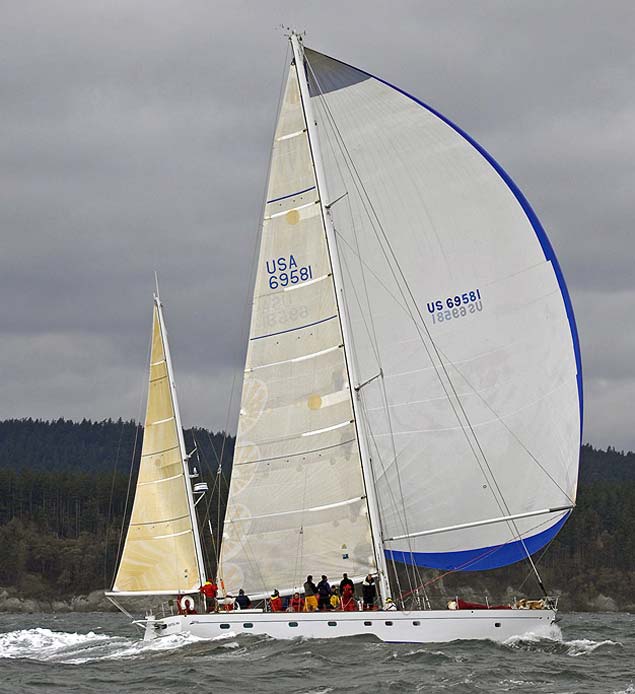 The Maxi Ondine, skippered by Jamie Young
The Maxi Ondine, skippered by Jamie Young
So not surprisingly Jamie’s enthusiasm for eco-friendly means of getting about the seas and oceans in a commercially and possibly socially-useful manner with a positive reliance on sails easily handled with modern technology has become ever-stronger over the years. He takes up the story:
The Sail Trading Project
By Jamie Young
The pull of the sea is strong and once hooked, it becomes central to your being. Very few of my broad family have or had the faintest interest in the sea, but after my first sail in the late 1950s with one of my cousins, I was hooked.
That cousin happened to be Wallace Clark, renowned for his definitive book about cruising round Ireland. But back in the 1950s, Sailing Around Ireland was yet to be published (it first appeared in 1976), and I was just a small boy who’d been brought along with adults to be taken for a sail somewhere off the coast of Northern Ireland, a small boy who was simply put under the foredeck of the daysailer on which this family obligation was being fulfilled. Yet I became hooked on sailing because of it.
What followed was a continued fascination with the sea and voyaging in various capacities and places: sea kayaking around Cape Horn; sailing Blondie Hasler’s special junk-rigged Folkboat Jester to the USA with Mary for our honeymoon; working as Skipper on the Maxi Ondine on many oceans; solo participant in another engine-less boat in the ’76 OSTAR - and solo return; the AZAB to the Azores and back; the Three Peaks; and many other voyages that I felt lucky to be able to enjoy, including more recently two to the West Coast of Greenland.
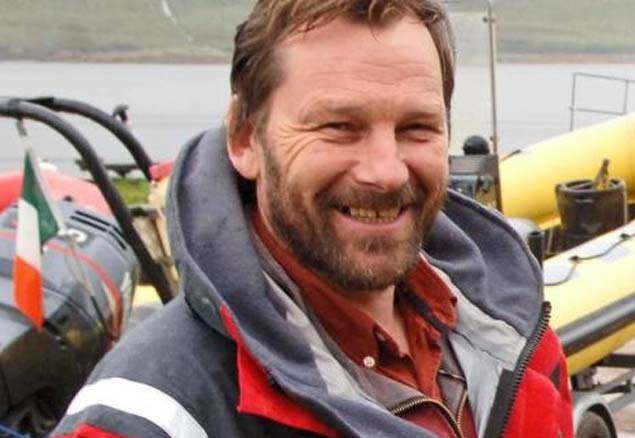 Man of the mountains, man of the sea - multiple adventurer Jamie Young of Killary. He feels that traditional sail training may have had its day and that to be meaningful, it now needs to be allied to some form of commercial sailing.
Man of the mountains, man of the sea - multiple adventurer Jamie Young of Killary. He feels that traditional sail training may have had its day and that to be meaningful, it now needs to be allied to some form of commercial sailing.
The stories and the reasons that surround these experiences are for another time. But all seem to have led to a specific interest which has led to many queries branching outwards towards an exciting and necessary future in what I call ‘Sail Trading’.
Having been part of the big boat racing circuit - albeit 40 odd years ago - I remain fascinated by the latest racing machines, including short-handed, solo, fully crewed, Round the World, and America’s Cup. Yet I can’t help but wonder why this fast-adapting technology cannot be put to another parallel use, and create efficient cargo sailing/renewable energy combination vessels.
And I would include creating some tech to prevent the increasing prevalence of vessels, sail and cargo, hitting and killing marine life or causing damage to both parties, for although this gruesome image results from a whale and ship collision, does anyone think when an IMOCA 60 at thirty knots is damaged by its keel hitting a whale, that the unfortunate whale is not also seriously and possibly fatally injured?
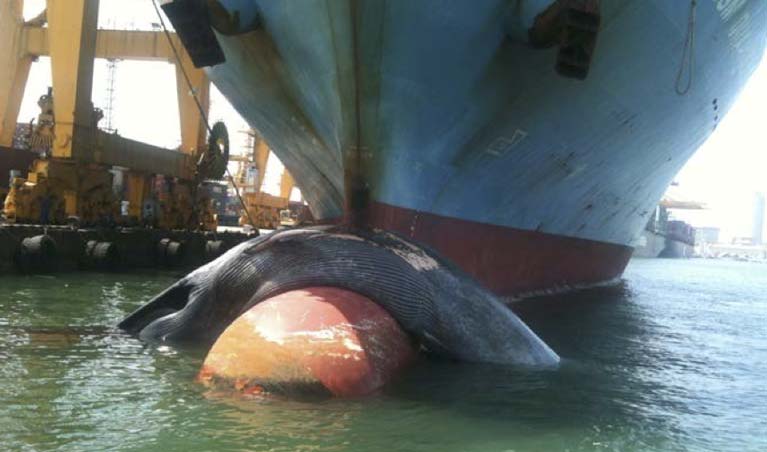 The tragic result of vessels in a hurry – a fatally injured whale impaled on the bow-bulb of a big ship
The tragic result of vessels in a hurry – a fatally injured whale impaled on the bow-bulb of a big ship
We can no longer have contempt for our natural environment, and as foils increase speeds to be seen as lethal cutting instruments, we should pause for thought…. Since we now have digital Doppler radar that can spot a buoy miles away, where is the responsibility and options to make a positive contribution to sustaining ocean wildlife? As Gandhi said: ‘There is more to life than just increasing its speed’.
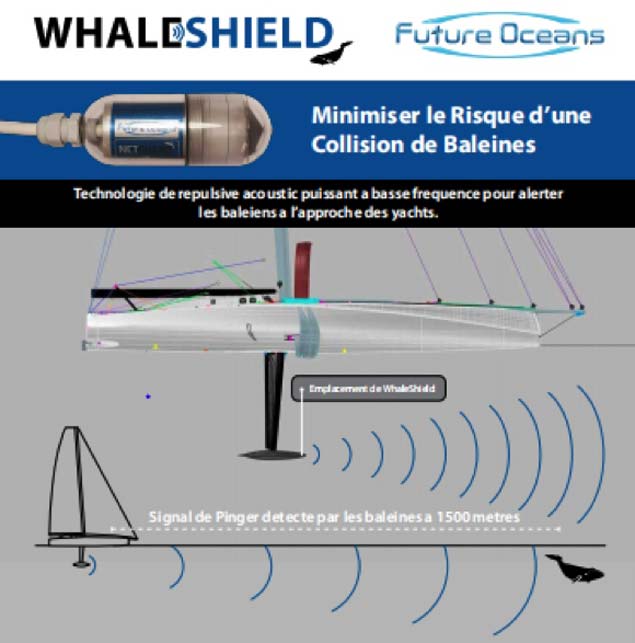 The Future Oceans group have created the Doppler radar Whaleshield
The Future Oceans group have created the Doppler radar Whaleshield
On a more positive note and back to ‘Sail Trading’, there is now a growing effort to consider again using the wind to power cargo vessels and ideally, it’s time for Ireland to get involved as an island nation, bearing in mind the historical trading activity between France and Iberia from Ireland’s west coast, from which the likes of Grace O’Malley and Daniel O’Connell greatly benefitted.
An interesting Irish connection that has blossomed into a regular transatlantic trade - both goods and passengers - is the Brigantine Tres Hombres. She was once a ferry to the Aran Islands from Galway in the ’70s and called Boidin. But she did start her life in the Baltic, and I am sure has many stories buried in the woodwork of her long life. She was discovered abandoned in Galway docks, towed back to Holland and slowly rebuilt to modern standards into the vessel you see today.
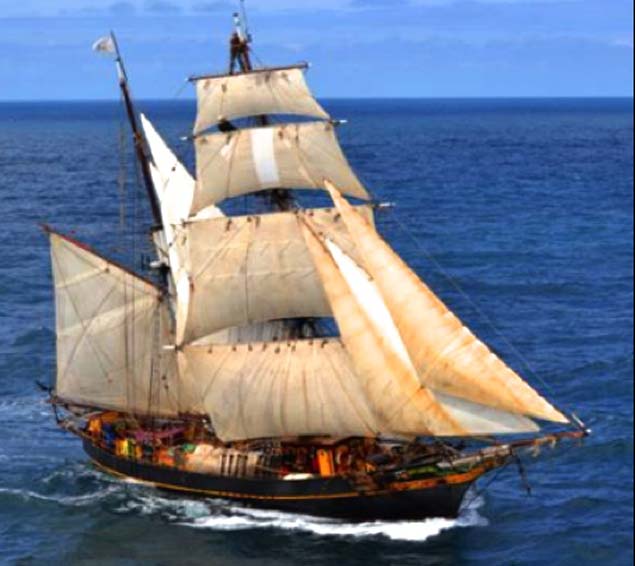 The commercial sailing ship Tres Hombres is the former Aran islands ferry Boidin
The commercial sailing ship Tres Hombres is the former Aran islands ferry Boidin
There are encouraging new builds, with some based on traditional lines as in the project CEIBA in the jungles of Costa Rica. This is fast taking shape, the difference being that she will have an electric auxiliary motor powered by renewables. The pictures show what the outcome will be, and she is now framed with the photo showing the full size lofting floor beside her present build. Her trading plans are more local to Costa Rica and around the Gulf of Mexico, but who knows what more distant opportunities may arise.
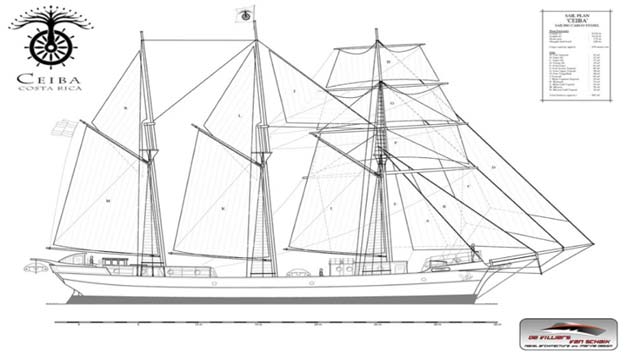 The Costa Rican Three-Master will be run as a commercial trading vessel
The Costa Rican Three-Master will be run as a commercial trading vessel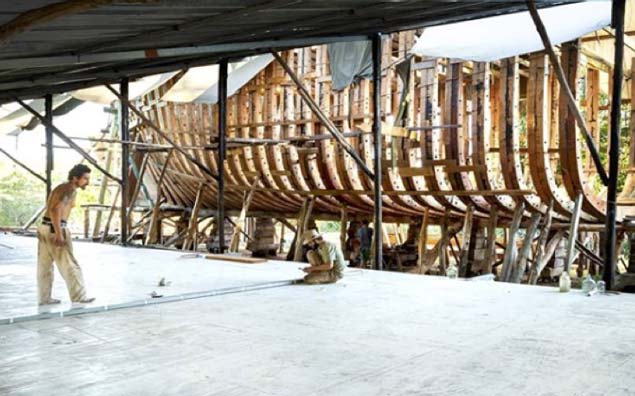 The Costa Rican three-master is in build in traditional timber style
The Costa Rican three-master is in build in traditional timber style
There are also a number of forward-looking projects that are looking at new technologies or adapting existing ones and these are equally fascinating. Energy Observer was originally a Nigel Irens catamaran from 1983, perhaps best known as ‘ENZA New Zealand’ when Sir Peter Blake and Sir Robin Knox Johnston set records with her. After only just returning from an initial round the world, she has been lengthened and further adapted for another four-year circumnavigation using purely renewables, while most interestingly creating hydrogen via solar as part of the motive power, which will also be augmented with rotating sails which are called ‘Oceanwings’:
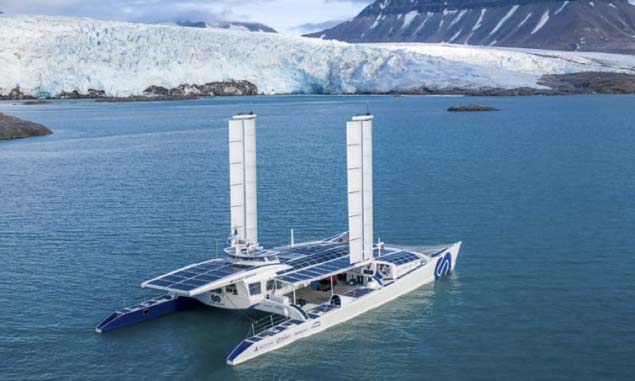 Originally the Nigel Irens catamaran ENZA New Zealand, Energy Observer has been lengthened for a second circumnavigation entirely using renewable energies and her oceanwings rotating sails
Originally the Nigel Irens catamaran ENZA New Zealand, Energy Observer has been lengthened for a second circumnavigation entirely using renewable energies and her oceanwings rotating sails
More interesting again are two orders for sail-assisted large cargo vessels for a particular transatlantic route, mainly machinery deliveries. The first build is recently announced and under way from Neoline:
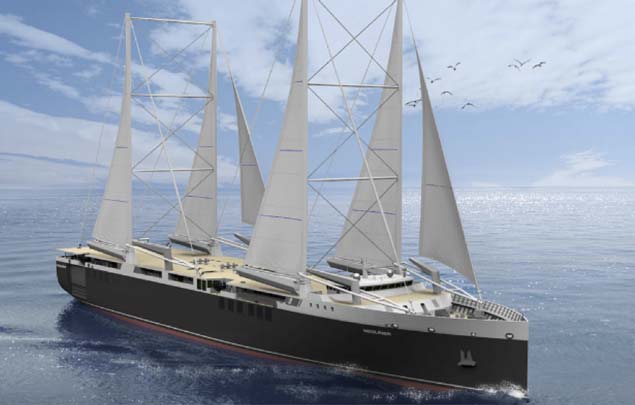 Two of these sail-assisted large cargo vessels from Neoline are currently in build
Two of these sail-assisted large cargo vessels from Neoline are currently in build
What I am most interested in initially is the build and operation of a multi-use sail trading vessel based on the current Votaan 72 example under construction in France. This is being built in the Alumarine-shipyard at Saint-Nazaire, near Lorient in Brittany.
The Votaan 72 is planned to have a 35-ton cargo capacity - 72 feet long - made of aluminium so minimum maintenance costs - nearly 100% recyclable - Two masts - 4 crew.
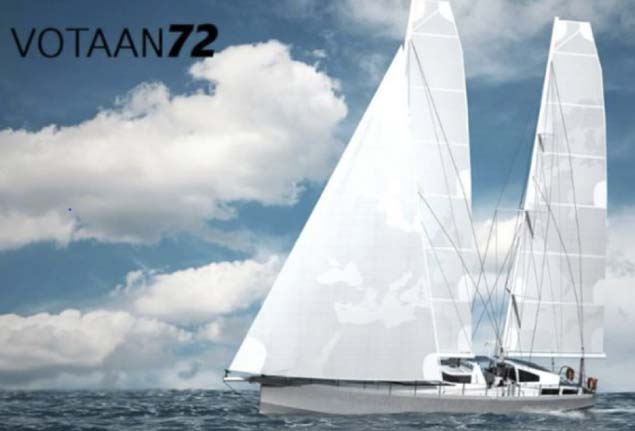 The Votaan 72 is building in France in aluminium
The Votaan 72 is building in France in aluminium
This project is of a size and scale that makes it possible from several directions: finance - maintenance - crew - access – materials. And it shows that with breadth of vision, we can think of it in multi-use terms. And what does ‘Multi-use’ mean? To make this a viable enterprise in the first instance, the roles envisaged would be:
- Cargo vessel between set ports on a common route. This might suit a corporate body that is prepared to ship by ‘traditional’ means and benefit from this exposure - with professional marketing input.
- As a marketing tool for a selection of companies to different ports where a mini ‘trade show’ can be held - again with professional marketing input - at those chosen destinations.
- As exposure to the sea for trainees not just from a traditional perspective of sea time, but access to transferable skills more modern in nature - and skills not confined to the marine sector.
- These skills would consist of: use of the comprehensive digital tools now available to mariners - interspersed with use and understanding of traditional methods of navigation and weather forecasting - and dealing with life on board out of sight of land and with no TV/internet…..
- This process could be increased by having the ability to adapt the vessel from a crew max of 6 on regular routes, while also adapting the cargo area to a max of 12 passengers on more defined sailing experiences.
- This would be all about the spirit of adventure and youth development, but with a modern twist that could include the transferable skills mentioned.
- Part of this would, therefore, be the ability to ship at set times the adventure sports equipment which allows for shore experiences. (Kayaks - camping - photography - etc.), and the possibility of research projects that can contribute to the development of further climatic solutions.
- Encourage a program of plastic & general rubbish collection on some of Ireland’s more remote coastline locations and islands.
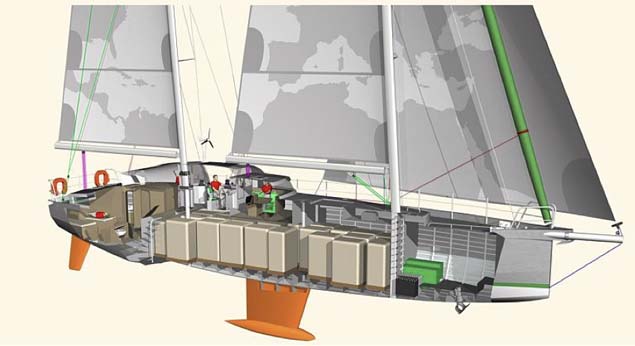 The Votaan 72 cargo space can be re-purposed to provide extra crew accommodation
The Votaan 72 cargo space can be re-purposed to provide extra crew accommodation
With some regret, I am further of the opinion that traditional sail training or personal development style voyages and ships, while they have their place, are not where the future lies in this area, and certainly not in Ireland. We have to excite and encourage by osmosis and foster a lifelong interest in all things maritime, including an interest in adopting new technologies in other areas that lessen mankind’s climate footprint.
There may be other such uses, but the initial emphasis will be on variety while the project crystallises. This is based on the first instance, however, it is planned, that once the concept stabilizes, a more complete and structured program will emerge.
Because this concept is what you could call a “Re-emerging Trend”, with the correct business structure it is possible that after a number of years the vessel would be sold on and another ‘improved’ version built. Maybe: bigger - more efficient - using now established cargo routes - re looking at possible technological advantages - looking towards new and/or different markets.
FINANCE
The overall monetary concept is to create a self-financing model of operation, and indeed - in time - to make it a profitable enterprise. This will require accountancy skills way beyond my level of competence, however, though I might have notions…!
As my Arctic sailing vessel ‘Killary Flyer’ is presently berthed at the friendly and efficient Mooney’s Boatyard in Killybegs, whenever I visit I am amazed at both the size and complexity of the huge fishing vessels moored up. Never mind the international examples raping the west coast on ‘MarineTraffic’, surely there must be a financial lesson there?
Thus, there are a couple of models to consider:
- Tax-efficient trading company based on purely commercial considerations, suitable for corporate investment. Trading with varied high-value cargo - not time-specific between set ports.
- Sourcing funds from an EU project. These might be a little light in view of current circumstances globally…
- Crowdfunding to the Irish - and other - diaspora. This is a comparatively new method of raising funds, but with my purchase of an electric bike via Indigogo last year - where they managed to raise €16M – it certainly provides food for thought.
- And crowdfunding comes - as far as I am aware - in two styles: creating a product that funders get at a discount when successfully launched – it’s basically seed money.
- Or where the visuals/story created are the story, which is funded via regular online postings. It is now longer possible to ‘disappear over the horizon’ thus, as Point F above, one of the skill sets to be developed by groups is social media engagement. With new satellite launches now regular and Inmarsat/Iridium prices falling, it is expected this would be a key tool of contact and interest in real-time.
- The purpose of this project/article, therefore, is to demonstrate that we are on the cusp of further strong sea transport evolution and Ireland should get on board and use its island position to develop this capacity and help benefit and encourage some of the youth of today, in an economical and affordable manner.
As the author, I intend to work away at the concept and believe this article will prompt others to get involved and I would encourage any reader to get in touch with queries - ideas - and help with the financials… Most of my ideas, whether it was sailing to Greenland or sea kayaking around Cape Horn, or indeed setting up a business in the west of Ireland during the ’80s, were greeted with astonishment. But here we are….
Nothing is set in stone at this stage and I am always receptive to solid worthwhile input, indeed I thrive on it.
Do we want to be one of the leaders of the pack in both modern youth engagement and exploring small vessel renewable trade?
Tanker Bunkers at Dun Laoghaire Harbour
Commercial shipping traffic might be reduced to very little in Dun Laoghaire Harbour these days but it is not gone entirely as witnessed by the arrival of a tanker this weekend.
The 'Kowie' discharged in Dublin Port on Friday night but the city port did not have a berth available for the ship to bunker but was facilitated on the Carlisle Pier at Dun Laoghaire.
Perhaps such overflow may be a regular sight at the South Dublin Harbour with Brexit around the corner?
Damaged Ship Still Being Detained Near Kinvara, Co Galway
Irish authorities are still detaining a cargo ship close to Kinvara in south Galway Bay after its hull sprang a leak while loading cargo for the Bahamas writes Lorna Siggins
As Afloat reported previously, the 30m ship Evora was detained last week at Tarrea pier near Kinvara by the Marine Survey Office (MSO) under port-state control regulations which prevent the vessel from going to sea.
Concerns about the four crew employed for the voyage also prompted a visit to the vessel by the International Transport Federation’s (ITF) Irish branch.
ITF representative Michael Whelan said he had met the crew – three Cubans and a Colombian – to check on their situation in relation to pay, conditions, and accommodation for the crew while the vessel is damaged.
The cargo ship had been due to steam to the Bahamas with a large quantity of cement when the ship’s hull was damaged during loading at Tarrea pier.
Local residents feared that fuel from the ship might leak, causing pollution which would have a serious impact on south Galway’s shellfish industry, including its oyster beds.
The owner said there had been no fuel leak from the vessel and no pollution risk.
The pier is outside the remit of the Galway harbourmaster and is the responsibility of Galway County Council.
It is understood residents found it difficult to get a response from the local authority, and Galway harbourmaster Capt Brian Sheridan intervened to assist.
The Department of Transport, under which the Marine Survey Office operates, said it could not comment on the details of the detention.
It said that any queries should be directed to the ship’s flag state – as in Saint Vincent and the Grenadines. However, the ship's port of registry is recorded as Panama on the vessel.
The vessel, built in France 50 years ago, was formerly owned in Rossaveal, Co Galway, but was sold to a new owner within the past 12 months.
The owner confirmed that the vessel had been held as the engine room was flooded, and said: "no harmful substances were released into the bay".
The ITF representative Michael Whelan said he was in regular contact with the crew, and understood they now wished to be repatriated. He confirmed that the crew had been paid, but did not wish to stay indefinitely, as the vessel had not been inspected by flag state inspectors as of yesterday.
Ship Holed at South Galway Pier Detained by Irish Authorities as Residents Fear Pollution Risk
Irish authorities have detained a cargo ship close to Kinvara in south Galway bay after its hull sprang a leak while loading cargo for the Bahamas writes Lorna Siggins
The 30m ship Evora has been detained by the Marine Survey Office (MSO) under port-state control regulations which prevent the vessel from going to sea.
Concerns about the four crew employed for the voyage also prompted a visit to the vessel yesterday by the International Transport Federation’s (ITF) Irish branch.
ITF representative Michael Whelan said he had met the crew – three Cubans and a Colombian – and was assessing the situation in relation to pay, conditions, and accommodation for the crew while the vessel is damaged.
“The situation is ongoing, and I have been in contact with the vessel owner,” Mr Whelan said.
The cargo ship had been due to steam to the Bahamas with a large quantity of cement when the ship’s hull was damaged during loading at Tarrea pier, outside Kinvara.
Local residents feared that fuel from the ship might leak, causing pollution which would have a serious impact on south Galway’s shellfish industry, including its oyster beds.
The pier is outside the remit of the Galway harbourmaster and is the responsibility of Galway County Council.
It is understood residents found it difficult to get a response from the local authority, and Galway harbourmaster Capt Brian Sheridan then intervened to assist.
The Department of Transport, under which the Marine Survey Office operates, said it could not comment on the details of the detention.
It said that any queries should be directed to the ship’s flag state – as in Saint Vincent and the Grenadines, where the vessel is registered.
The vessel, built in France 50 years ago, was formerly owned in Co Galway but was sold to a new owner within the past 12 months. The owner confirmed that the vessel had been detained, but did not comment further.
A spokesman for the Evora said that the vessel was "detained due to flooding of the engine room" and that "no harmful substances were released" to surrounding waters.
The spokesman said there were "no further comments".
What You Didn't Know About Cruise–Ship Safety
It may have to take another disaster of Titanic proportions before lifesaving provisions on board cruise ships are improved.
That might seem like a bit of hyperbole – an exaggerated statement or claim not meant to be taken literally, but it came from a maritime source which deserves respect – an international forum of professionals.
• Listen to the Podcast below.
NAUTILUS is the international trade union and professional organisation representing more than 22,000 maritime professionals in the UK, theNetherlands and Switzerland. Its International Professional and Technical Forum issued that warning after a meeting in Hull in England where facts that will surprise the public about cruise ship safety were revealed.
As cruise ships get bigger and bigger, with a 6,000 passenger capacity amongst the biggest, fears have been increasingly expressed about safety and evacuation procedures, which were heightened by the Costa Concordia disaster.
It is surprising to hear that every passenger is not guaranteed a seat in a lifeboat and that some passengers, because of their size, might not even fit in lifeboat seats. According to the NAUTILUS professionals, the SOLAS, safety of life at sea regulations, only require that there is lifeboat capacity for 37.5 per cent of passengers on each side of a cruise ship, providing that liferafts increase that capacity to 125 per cent, meaning apparently that not every passenger would be catered for in a lifeboat in an emergency.
And even if seats are available, the Forum was told that seats only allow for an average mass of 75 kilograms per person and a seat with of 16.9 inches which, the professional forum concluded, does not take into account increases in the average height and weight of passengers.
The general public will be surprised by these findings, the NAUTILUS professionals said. They have called for a lifeboat seat for every passenger onboard – and a guarantee that passengers will fit into them.
The professionals said that passengers may be surprised to learn that this is not already the case.
World War I Shipwrecks Revealed Round Irish Coast
A team of scientists led by Dr Ruth Plets, School of Environmental Sciences at Ulster University, aboard the Marine Institute's Celtic Voyager research vessel has revealed detailed images of World War I shipwrecks in the Irish Sea.
The team set out to capture the highest resolution acoustic data possible of WWI shipwrecks lost in the Irish Sea, using a new multi-beam system (EM2040) on board the RV Celtic Voyager to get the best data ever acquired over these
wrecks.
"We were able to capture the most detailed images of the entirety of the wrecks ever. Some of the wrecks, which are too deep to be dived on, have not been seen in 100 years. So this is the first time we can examine what has happened to them, during sinking and in the intervening 100 years, and try to predict their future preservation state," explained Dr Plets.
Among the shipwrecks surveyed were the SS Chirripo, which sank in 1917 off Black Head (Co. Antrim) after she struck a mine; the SS Polwell, which was torpedoed in 1918 northeast of Lambay Island; and the RMS Leinster, which sank in 1918 after being torpedoed off Howth Head when over 500 people lost their lives – this was the greatest single loss in the Irish Sea.
Dr Peter Heffernan, CEO Marine Institute welcomed the achievements of the survey, supported by the competitive ship-time programme: "The multidisciplinary team is making an important contribution to understanding and protecting our maritime heritage and to our ability to manage our marine resource wisely".
Explaining how the survey was carried out Dr Plets said, "We moved away from traditional survey strategies by slowing the vessel right down to allow us to get many more data points over the wreck, with millions of sounding per
wreck."
"The detail is amazing as we can see things such as handrails, masts, the hawse pipe (where the anchor was stored) and hatches. Some of the vessels have split into sections, and we can even see details of the internal structure. With the visibility conditions in the Irish Sea, no diver or underwater camera could ever get such a great overview of these wrecks."
As well as acoustic imaging, the team collected samples from around the wreck to see what its potential impact is on the seabed ecology. Sediment samples were also taken for chemical analysis to determine if these wrecks cause a
concern for pollution.
The project is carried out to coincide with WWI centenary commemorations, noted Dr Plets, "We often forget the battles that were fought in our seas; more emphasis is put on the battles that went on in the trenches. However, at least 2,000 Irishmen lost their lives at sea, but unlike on land, there is no tangible monument or place to commemorate because of the location on the bottom of the sea,"
"In the Republic of Ireland there is a blanket protection of all wrecks older than 100 years, so all these will become protected over the next few years.
To manage and protect these sites for future generations, we need to know their current preservation state and understand the processes that are affecting the sites," Dr Plets further stated.
The next step for the team is to use the data collected to create 3D models which can be used for archaeological research, heritage management and dissemination of these otherwise inaccessible sites to the wider public.
"There is so much data, it will take us many months if not years, to work it all up. Some of the wrecks are in a very dynamic environment and we are planning to survey these vessels again next year to see if there is a change, especially after the winter storms. That will give the heritage managers a better idea if any intervention measures need to be taken to protect them," said Dr Plets.
"These data could well signal a new era in the field of maritime archaeology. We hope it will inspire a new generation of marine scientists, archaeologists and historians to become involved. Above all, we want to make the general public, young and old, aware of the presence of such wrecks, often located only miles off their local beach."
The research survey was supported by the Marine Institute, through its Ship-Time Programme, funded under the Marine Research Programme by the Irish Government.
The diverse team included maritime archaeologists Rory McNeary, from the Northern Ireland Department of the Environment, and Kieran Westley, from the University of Southampton; geologists Rory Quinn and Ruth Plets, both Ulster University; biologists Annika Clements, from Agri-Food and Biosciences Institute, and Chris McGonigle, from Ulster University; Ulster University Marine Science student, Mekayla Dale; as well as hydrographer Fabio Sacchetti from the Marine Institute who works on Ireland's national seabed mapping programme, INFOMAR, run jointly with the Geological Survey of Ireland.
131–ft Super Yacht Dropped During Cargo Ship Lift
#superyachtdrop – Time to check your insurance policy! This 131ft superyacht was being hoisted on a container vessel in the port of Colon in Panama on Tuesday.
However, this routine procedure went wrong when the lifting straps around the superyacht broke, dropping the vessel onto the deck as the vid above shows (at about 0.48 seconds on the timeline).
Irish Maritime Industry Leaders Gather for the First Time At Cork Forum
#maritime – The first ever Irish Maritime Forum was held today (Friday, 26th September 2014) in Cork's City Hall. Hosted by the Port of Cork, in partnership with the Irish Ports Association, the forum was attended by over 150 delegates from across the maritime industry.
Entitled 'Developing the Dynamic Future for Ireland's Maritime Sector', the forum focussed on the challenges and opportunities faced by those operating within the maritime sector, both in Ireland and in Europe.
Opening the conference, Minister Sean Sherlock TD spoke of the importance of ports as strategic points for trade growth, both nationally and internationally. He highlighted the Port of Cork and other Irish ports as global benchmarks and commended them for their future vision.
Guest speakers at the forum included Vincent De Saedeleer, Vice President of the Port of Zebrugee; Mr Alan Gray, Managing Director of the Indecon International Consulting Group; Captain Fredrik Van Wijnen, General Secretary of the Confederation of European Shipmasters' Associations (CESMA), Isabelle Ryckbost, Secretary General of the European Sea Ports Organisation (ESPO) and Patrick Verhoeven, Secretary General of the European Community Shipowner's Association (ECSA).
Speaking at the forum, John Mullins, Chairman of the Port of Cork, said: "I am delighted to be opening the inaugural Irish Maritime Forum here in Cork. This is a unique opportunity for industry leaders to come together and develop ideas for change. These ideas need to be put to policy makers to shape future government policy for the sector and I hope that is something that we can achieve here today".
Brendan Keating, Chief Executive of the Port of Cork continued, "We know that ports are a key element for national economic growth, particularly as Ireland emergences from recessionary times. However adequate port infrastructure is critical for future growth."
The forum will continue throughout the afternoon and will culminate with a gala dinner also in City Hall for over 200 guests.
#Marine Notice – No. 61 of 2013. This Marine Notice supersedes Marine Notice No.16 of 2007
Notice to all Owners/Operators of Passenger Ships, Cargo Ships engaged on Domestic Voyages in Ireland, Masters, Local Authorities and Harbour Masters
Maritime Security Measures for Vessels operating on Domestic Voyages in Ireland – Commencing November 2013
Background
EU Regulation (EC) No 725/2004 – Enhancing Ship and Port Facility Security – entered into force on 31 st March 2004.
The objective of this Regulation is to introduce and implement measures aimed at enhancing the security of ships used in international and domestic trade, and associated port facilities within the Member States, in the face of threats of intentional unlawful acts.
Article 3.3 of the Regulation requires that Member States shall, after a mandatory security risk assessment, decide the extent to which they will apply the provisions of this Regulation to different categories of ships operating on national domestic services, their companies and the port facilities serving them.
Member States must notify the Commission of such decisions when they are adopted, as well as of the periodic review, which must take place at intervals of no more than five years.
The Marine Survey Office (MSO) of the Irish Maritime Administration has completed a five year review of security risk assessments for vessels and ports engaged in domestic shipping operation on the Irish coast.
The risk assessment undertaken, took into account a number of considerations:-
• Vessel type
• Size of vessel
• Cargo
• Operating area
• Port facility location base
• Port facility infrastructure
• Interaction with international shipping traffic
• Seasonality of vessel operations
• Passenger numbers
• Nationality of passengers
• Possible threat scenarios posed to, and by, such vessels.
The maritime security measures to be applied as a result of the risk assessment relate to vessels and are defined in the following text.
Maritime Security Measures Applicable to Irish Registered Vessels engaged on Domestic Voyages to sea in Irish waters from November 2013
Vessel security measures must be applied by their owners/operators on the following basis.
Vessel Type 1:
• Passenger vessels carrying in excess of 100 passengers
• Cargo Vessels of 500 GT or more
Such vessels proceeding to sea on domestic voyages must implement the following security measures for their vessel, including:
Appointing a Company Security Officer,
Appointing a Ship Security Officer,
Creating a vessel specific security plan, and
Ensuring all relevant staff undertake suitable security training.
Vessel Type 2:
• Passenger vessels carrying 100 passengers or less
• Cargo vessels less than 500 GT
The above vessels are not required to create formal security plans but must implement guidelines contained in the Annex of this Marine Notice.
Maritime Security Measures Applicable to all Vessels, which do not proceed to Sea, (Smooth and Partially Smooth Waters) from November 2013
Vessel Type 3:
• Passenger & Cargo vessels not proceeding to sea on Domestic voyages
Such vessels are strongly recommended to implement the security guidelines contained in the Annex of this Marine Notice on a voluntary basis.
Maritime Security Measures Applicable to Non-Irish Registered Vessels engaged exclusively on Domestic Voyages to sea within Irish Waters from November 2013
In the case of non-Irish registered vessels operating exclusively on domestic voyages to sea, the following will apply:
Such vessels engaged on exclusive domestic service – no more favourable treatment clause applies prior to entering into service. De minimus rule also applies.
EU Flag >100pax or >/=500GT, must comply with Irish Domestic security requirements for Vessel Type 1, in addition to any imposed by their own Flag administration.
EU Flag =/<100pax or <500GT, comply with their own flag requirements and also with Irish guidance as per Vessel Type 2.
All non-EU Flag vessels, regardless of size or number of passengers, must comply with their own flag requirements and specified domestic security requirements as for Irish flag Type 1 & 2 vessels, as appropriate. An additional risk analysis will be carried out by the MSO in respect of such vessels and any resulting requirements are to be complied with prior to entering into service.
The Guidelines for security of domestic shipping proceeding to sea are contained in the Annex to this Marine Notice and are intended to assist managers of domestically operating ships to enhance security on their vessels.
The guidelines may form the basis for companies required to create a mandatory security plan for their vessels.
The MSO can provide a Security Plan Template to assist those owners required to implement mandatory security measures (Vessel Type 1).
Marine Notice No. 16 of 2007 is hereby revoked.
Irish Maritime Administration,
Department of Transport, Tourism and Sport,
Leeson Lane, Dublin 2, Ireland.
07/11/2013
Encl. : Annex
For any technical assistance in relation to this Marine Notice, please contact:
The Marine Survey Office, Leeson Lane, Dublin 2, tel: +353-(0)1-678 3400.
For general enquiries, please contact the Maritime Safety Policy Division, tel: +353-(0)1-678 3418.
Written enquiries concerning Marine Notices should be addressed to:
Irish Maritime Administration, Dept. of Transport, Tourism and Sport, Leeson Lane, Dublin 2, Ireland.
email: [email protected] or visit us at: www.dttas.ie
ANNEX to Marine Notice No. 61 of 2013
Security Guidelines for Vessels engaged on Domestic Voyages to Sea
1.0 Access Restrictions on board ALL vessels.
1.1 Non Public areas of vessels should be controlled to prevent unauthorised access. Such areas would include:
Wheelhouse
Machinery spaces
Cargo Storage Areas
Storage Areas
Crew Accommodation
Mooring stations
Emergency Control points.
Safety Equipment storage lockers e.g. Lifejackets, First Aid, Fire Extinguishers.
1.2 Means of control can include:
Padlocks
Shipboard ID System for Crew / Employees
Keypad access control
Local alarming of doors
Security tagging of items with anti-tamper seals
CCTV Installation
Provision of signage identifying an area as restricted to passengers
Crew undertaking regular patrols to check
2.0 Access Control
2.1 Embarking and disembarking of passengers should only occur via a suitable gangway.
2.2 Embarking and disembarking passengers should always be kept separate.
2.3 Embarking must only be allowed when the crew are present on board to receive the passengers and the vessel has been inspected for any unattended or unusual items.
2.4 Embarkation must not occur while cleaning or maintenance of a vessel is being undertaken.
2.5 Passengers must present valid tickets to crew, prior to being allowed on board.
2.6 Particular attention must be paid by the crew when the tidal conditions present the vessel level with a pier to avoid the instance of an unauthorised boarding of the vessel other than by the gangway.
2.7 In the cases of charter groups, the charter representative travelling should:
Advise the vessel of group number travelling
Muster at an agreed location away from the vessel and account for their group prior to boarding
Confirm numbers of mustered group to the vessel.
The boarding of such groups should be overseen and numbers confirmed by a crewmember that liaises with the organiser. A counting device such as a clicker should be used to account for number of persons boarding.
3.0 Pre-departure security announcements
3.1 Pre-departure announcements should advise passengers:
Not to leave any baggage unattended
Report any suspicious items noted on board
Not to enter any restricted areas on board
Consideration should be given to having such advice issued as security posters on board.
4.0 Luggage carried on board
4.1 Unaccompanied luggage should not be placed on board unless satisfactory means of verifying its contents are provided.
4.2 Unless there is a central luggage store, passengers should be, for security purposes, instructed to remain with their luggage at all times.
4.3 On completion of any trip and prior to the next departure, the vessel should be swept for any remaining unaccounted luggage items.
5.0 Visitors and repair contractors
5.1 Official visitors and contractors should present themselves initially to the shore office for clearance prior to attempting to board any company vessel.
Contractors should be asked to provide proof of identification. Passport, Drivers licence or verified company ID are acceptable means of proof.
5.2 A dedicated visitor's pass should be provided by vessel operators, with associated records of who has accessed their vessels.
5.3 Visitors and contractors should be given a security / safety briefing prior to boarding the vessel.
6.0 Security Patrols
6.1 Security patrols are most effective as a deterrent when carried out by uniformed staff and crew members, and improve the chances of recognising unattended or concealed items.
6.2 Items of uniform may include company branded Hi Visibility vests, tee shirts, coats, boiler suits etc.
6.3 Such duties should be shared between suitable trained crew and should be incorporated into their regular duties and routines.
6.4 An agreed search procedure should be in place by the operator to include a check of:
All passenger areas including toilets and luggage storage areas
Cargo holds and common work areas of cargo vessels
Integrity of all restricted areas on board after each voyage.
7.0 Securing Vessels
7.1 Where practical, external doors and storage areas should be kept locked shut, while allowing means to exit rapidly from within the vessel in the event of an emergency.
7.2 If the vessel is left unattended for a period of time such as overnight or seasonal lay-up, the engines should be disabled to prevent theft or unauthorised use.
7.3 Out of service vessels should be securely moored.
7.4 Gangways should be lifted and not left in position on an unattended vessel.
7.5 In ports with mobile security patrols, security staff should be aware of the status of vessels berthed in their port, e.g. laid up, visitor, overnight stay etc.
7.6 Owners should consider the installation of a basic alarm system to detect and warn against tampering with out of service vessels.
8.0 Standard Operating Procedures (SOPs)
8.1 SOPs recommended to be established:
Response to bomb threats
Visiting contractors
Cleaning routines
Vessel inspection routine
Securing of vessel when out of service and security sweep prior to re-entering the vessel.
9.0 Emergency contacts list
9.1 All operators should compile a list of emergency contacts, which should be kept on board the vessel for use in the event of any potential security or even a suspicious incident. The contacts list should include but not be limited to:
Local Garda Station
Local Garda Crime Prevention Officer (for advice on security)
Regional Marine Survey Office (Department of Transport, Tourism & Sport)
Local Harbour Masters (if applicable)
Irish Coast Guard – National Maritime Operations Centre (NMOC) (to report any security incident at sea).
10.0 Interagency Co-Operation
Operators are encouraged to discuss their security issues with other services and transport facilities, e.g. Bus Services, Cargo Haulage companies; advise them of their security ship board policies, and agree how these services can assist operators in implementing them.
Furthermore, operators are advised to meet with Local Authorities, Port Officials, Gardaí and the Department of Transport, Tourism & Sport to discuss their needs.



























